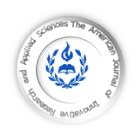



GENERAL INFORMATION

American Journal of Innovative Research & Applied Sciences



| ISSN: 2429-5396 (e) | www.american-jiras.com | |
| Web Site Form: v 0.1.05 | JF 22 Cours, Wellington le Clairval, Lillebonne | France |
| Web Site Form: v 0.1.05 | JF 22 Cours, Wellington le Clairval, Lillebonne | France |


ResearchBib, Google Scholar, SIS database, i.f.s.i.j, Scribd, IISJ, Eurasian Scientific Journal Index (ESJI), Indianscience.in, arastirmax, Directory of Research Journals Indexing, Pak Academic Sesearch, AcademicKeays, CiteSeerX, UDL Library, CAS Abstracts, J-Gate, WorldCat, Scirus, IET Inspec Direct, and getCited
Indexed by:
| HOME || ABOUT US || ARCHIVES || AIMS AND SCOP || AUTHORS || REVIEW|| SUBMIT MANUSCRIPT || EDITORIAL BOARD || CONTACT US |
| HOME | ABOUT US | ARCHIVE | AIMS AND SCOP | AUTHORS | REVIEW | SUMIBMIT MANUSCRIPT | EDITORIAL BOARED | PUBLICATION FEE |
| | ARTICLES | Am. J. innov. res. appl. sci. Volume 6, Issue 4, Pages 203-209 (April 2018) |
| Research Article |
American Journal of innovative
Research & Applied Sciences
Research & Applied Sciences
ISSN 2429-5396 (Online)
OCLC Number: 920041286
OCLC Number: 920041286

|
| APRIL VOLUME 6 | N° 4 | 2018 |
Authors Contact
*Correspondant author and authors Copyright © 2018:
| Çiğdem Gül 1 | Nurcihan Hacıoğlu Doğru *2 | and | Murat Tosunoğlu 3 |
*Correspondant author and authors Copyright © 2018:
| Çiğdem Gül 1 | Nurcihan Hacıoğlu Doğru *2 | and | Murat Tosunoğlu 3 |
Affiliation.
Çanakkale Onsekiz Mart University |Faculty of Arts and Sciences | Department of Biology | Canakkale | Turkey |
Çanakkale Onsekiz Mart University |Faculty of Arts and Sciences | Department of Biology | Canakkale | Turkey |
This article is made freely available as part of this journal's Open Access: ID | Çiğdem-ManuscriptRef.1-ajira160418 |
ABSTRACT
Back ground: there are many production factors and feed manipulations that affecting the meat chemical analysis sequent affecting meat quality and storage time. Objectives: these experiments are conducted to study the effect of nutrition and feed manipulation on meat traits. Material and Methods: This study comprised of four experiments. The first experiment was in the form of a feeding trial to study the effect of four levels and two sources of dietary fat on broiler chicks’ carcass traits. The second, third, and fourth experiments were designed to investigate the effect of three methods of feed restriction (quantitative feed restriction, calorie to protein ratio, and phase feeding) on broiler carcass chemical analysis. The birds used in the experiment were commercial unsexed hybrid broiler strain (Ross 308), purchased at day-old from a local hatchery in Khartoum (coral). They were reared in an open deep litter experimental house in the poultry unit of the faculty of Animal Production. A number of 210 uniform chicks were selected and assigned at random to each of the twenty one experimental pens, at the rate of ten chicks per pen. The experimental diets were randomly assigned to the experimental units (pens) at the rate of three replicates per treatment in a completely randomized design arrangement. The diets were fed for an experimental period of six weeks. Feed and water were supplied ad libitum, and records were kept for weekly feed intake, live weight and daily mortality. As a fat source and level, beef tallow was added to three of dietary treatments at the rate of 2.0, 4.0, and 6.0 percent; while vegetable oil (sunflower) was similarly added to other three dietary treatments. The seventh experimental diet was used as a control diet (without addition of fat). The second study was in form of a six week broiler feeding trials, in the poultry experimental unit of the Faculty of Animal Production. 90 out of the purchased 110 day-old chicks were reared on a deep litter floor in an open experimental house and divided in to three experimental chick groups and each group was replicated thrice and hence at random in rate of 10 chicks per pen. The control group was fed adlibitum throughout the experimental period while the other two groups were restricted in respective during the third and fourth weeks of age to 80%, and 60% of the control group allowance then re-alimenting during the last two weeks. Third study: a number of 90 unsexed day old commercial broiler chicks (Ross308) reared for six weeks in deep litter open house and assigned to three dietary treatments of different protein to calorie ratios: (23:3200 (1:139); 24:3170 (1:128); and 21: 3267 (1:154)) were examined. The experimental diets were randomly distributed among the experimental birds for the first three weeks of age then the birds on (1:128, or 1:154) diets were switched to a finisher diet (1:162) for the last three weeks while the birds on (1:139) were continued on the same diet. Fourth study: a number of 90 chicks (Ross308) from the healthy and uniform chicks were selected and (Ross308) reared for six weeks in deep litter open house and assigned randomly to the three dietary treatments each replicated three times (nine experimental pens, at the rate of ten chicks per pen). Treatment one consisted of one diet (starter) for all experimental period. Treatment two consisted of two diets (starter and grower) introduced three week for each. Treatment three consisted of three diets (starter, grower, finisher) each introduced for two weeks. The results: the dietary fat source and level significantly affect only ether extract and ash. With exception of nitrogen free extract with physical feed restriction, the three experiments revealed no significant (P<0.05) effect on the other chemical characteristics. Conclusion: The dietary fat source and level and physical feed restriction significantly only affect ether extract, ash and nitrogen free extract.
Key words: poultry, broiler, fat, carcass, chemical analysis.
Back ground: there are many production factors and feed manipulations that affecting the meat chemical analysis sequent affecting meat quality and storage time. Objectives: these experiments are conducted to study the effect of nutrition and feed manipulation on meat traits. Material and Methods: This study comprised of four experiments. The first experiment was in the form of a feeding trial to study the effect of four levels and two sources of dietary fat on broiler chicks’ carcass traits. The second, third, and fourth experiments were designed to investigate the effect of three methods of feed restriction (quantitative feed restriction, calorie to protein ratio, and phase feeding) on broiler carcass chemical analysis. The birds used in the experiment were commercial unsexed hybrid broiler strain (Ross 308), purchased at day-old from a local hatchery in Khartoum (coral). They were reared in an open deep litter experimental house in the poultry unit of the faculty of Animal Production. A number of 210 uniform chicks were selected and assigned at random to each of the twenty one experimental pens, at the rate of ten chicks per pen. The experimental diets were randomly assigned to the experimental units (pens) at the rate of three replicates per treatment in a completely randomized design arrangement. The diets were fed for an experimental period of six weeks. Feed and water were supplied ad libitum, and records were kept for weekly feed intake, live weight and daily mortality. As a fat source and level, beef tallow was added to three of dietary treatments at the rate of 2.0, 4.0, and 6.0 percent; while vegetable oil (sunflower) was similarly added to other three dietary treatments. The seventh experimental diet was used as a control diet (without addition of fat). The second study was in form of a six week broiler feeding trials, in the poultry experimental unit of the Faculty of Animal Production. 90 out of the purchased 110 day-old chicks were reared on a deep litter floor in an open experimental house and divided in to three experimental chick groups and each group was replicated thrice and hence at random in rate of 10 chicks per pen. The control group was fed adlibitum throughout the experimental period while the other two groups were restricted in respective during the third and fourth weeks of age to 80%, and 60% of the control group allowance then re-alimenting during the last two weeks. Third study: a number of 90 unsexed day old commercial broiler chicks (Ross308) reared for six weeks in deep litter open house and assigned to three dietary treatments of different protein to calorie ratios: (23:3200 (1:139); 24:3170 (1:128); and 21: 3267 (1:154)) were examined. The experimental diets were randomly distributed among the experimental birds for the first three weeks of age then the birds on (1:128, or 1:154) diets were switched to a finisher diet (1:162) for the last three weeks while the birds on (1:139) were continued on the same diet. Fourth study: a number of 90 chicks (Ross308) from the healthy and uniform chicks were selected and (Ross308) reared for six weeks in deep litter open house and assigned randomly to the three dietary treatments each replicated three times (nine experimental pens, at the rate of ten chicks per pen). Treatment one consisted of one diet (starter) for all experimental period. Treatment two consisted of two diets (starter and grower) introduced three week for each. Treatment three consisted of three diets (starter, grower, finisher) each introduced for two weeks. The results: the dietary fat source and level significantly affect only ether extract and ash. With exception of nitrogen free extract with physical feed restriction, the three experiments revealed no significant (P<0.05) effect on the other chemical characteristics. Conclusion: The dietary fat source and level and physical feed restriction significantly only affect ether extract, ash and nitrogen free extract.
Key words: poultry, broiler, fat, carcass, chemical analysis.
IMPACT OF SOME HEMATOLOGICAL AND MICROBIOLOGICAL FACTORS ON TWO NATRIX SPECIES IN THE BIGA STREAM (ÇANAKKALE, TURKEY)
| Çiğdem Gül 1 | Nurcihan Hacıoğlu Doğru *2 | and | Murat Tosunoğlu 3 |. Am. J. innov. res. appl. sci. 2018; 6(4):203-209.
| PDF FULL TEXT | | Abstract and Author Contact | | HTML FILE | | XML FILE | | Received | 06 March 2018 | | Accepted | 20 April 2018 | | Published 30 May 2018 |
| Çiğdem Gül 1 | Nurcihan Hacıoğlu Doğru *2 | and | Murat Tosunoğlu 3 |. Am. J. innov. res. appl. sci. 2018; 6(4):203-209.
| PDF FULL TEXT | | Abstract and Author Contact | | HTML FILE | | XML FILE | | Received | 06 March 2018 | | Accepted | 20 April 2018 | | Published 30 May 2018 |